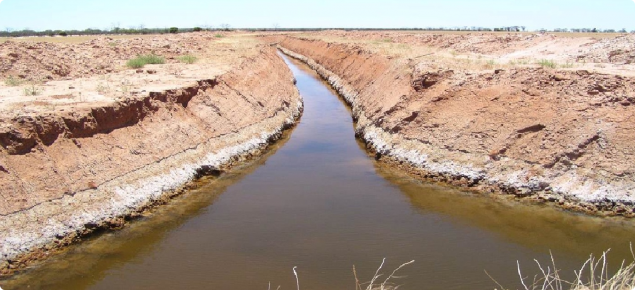Notifying the Commissioner of Soil and Land Conservation
Soil and Land Conservation Regulations 1992 were introduced to control the drainage of saline land in Western Australia. The regulations require landholders (owner or occupier) intending to drain or pump water from under the land surface and then discharge that water onto other land, into other water or into a watercourse, to notify the Commissioner of Soil and Land Conservation at least 90 days before discharging water. Notice is submitted using the notice of intent to drain or pump water (NOID) form. We apologise for having the old-department names on the form – the form is correct in every other way. See the new department names at the bottom of this page.
Desalination of groundwater with a reverse osmosis plant produces brine as waste, and the process requires a notice of intent to drain - desalination.
Please note: the NOID form refers to government departments before the restructures. The equivalent names are listed at the bottom of this page.
Notification allows for the proposed works to be assessed by the Commissioner (or the Commissioner's agent) and gives neighbouring landholders and public authorities the opportunity to comment on the drainage proposal. Notification relates to draining or pumping within the same property and across multiple properties. It is also required regardless of the salinity (or freshness) of the discharge water; if the intent of the drainage works is to control salinity by discharging water, notification is required.
Drainage that must be notified:
- all subsurface drainage for salinity control
- all surface and subsurface drainage in the Peel-Harvey Catchment.
Drainage that does not need to be notified:
Groundwater drainage good practice
In order, good practice by the landowner includes:
- site survey and recording of soil and water salinity (needed to assess success of drainage)
- planning and design at catchment and property level (see deep drainage for salinity management)
- notifying neighbours and getting their comments – Mandatory
- submitting a Notice of intent to drain to the Commissioner at least 90 days before construction – Mandatory
- having an onsite inspection of the proposed drain and discharge by a Commissioner's officer – Mandatory
- on receiving a 'no objection' response from the Commissioner, organising the works (with or without a contractor)
- constructing the drains using sound engineering designs (see Leveed groundwater drains and Open groundwater drains)
- monitoring rates of flow and water quality
- monitoring any changes in the surface salinity, and downstream changes (needed to assess success of drainage and unintended results)
- maintenance of the drain and discharge points.
Drainage principles
These principles from the Policy framework for inland drainage are used during the NOID process:
- Drainage should be considered within an integrated catchment management framework, as part of the total water cycle, and the quality and quantity of drainage water is managed.
- Environmental impacts, positive and negative, should be identified and described at a level appropriate to the scale of the drainage proposal. Proposals should demonstrate an overall environmental benefit.
- Public good from the proposal should be identified and be relative to the scale and risk of the proposal.
- Best practice appropriate to the scale and risks of the proposal should be used for planning, design, consultation, construction and management.
- Consultation and participation is expected for stakeholders affected by drainage proposals.
- Costs for design, construction, operation and maintenance shall be identified, allocated and agreed for the life of the drainage.
- Where necessary (depends on scale of the proposal), there should be documentation of governance, financial arrangements, and intentions for detailed design, access, construction, operation, maintenance, monitoring and evaluation, and allocation of liabilities.
New government department names
- The Department of Agriculture and Food is now the Department of Primary Industries and Regional Development (DPIRD).
- The Department of Water is now the Department of Water and Environmental Regulation (DWER).
- The Department of Environment and Conservation is now the Department of Biodiversity, Conservation and Attractions (DBCA).
- The Federal Department of Environment and Heritage is now the Department of Environment and Energy.
- The WA Department of Indigenous Affairs is now the Department of Planning, Lands and Heritage (DPLH).

